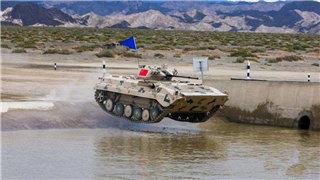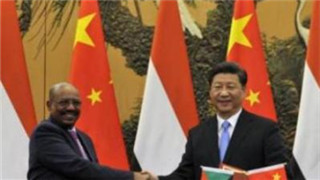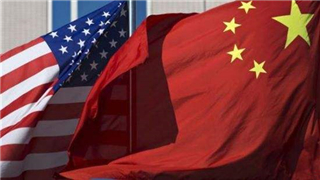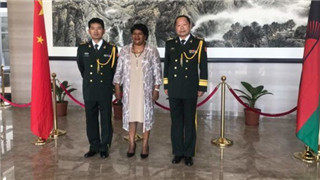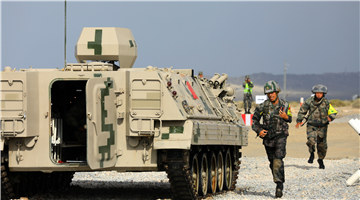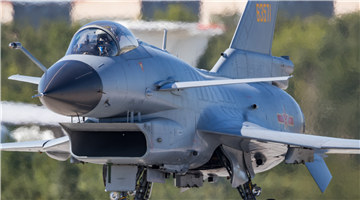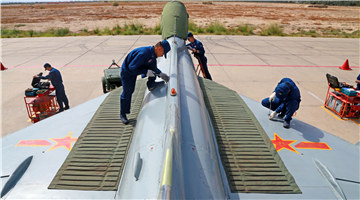By Wei Yunfeng
BEIJING, Aug. 3 (ChinaMil) -- The“International Army Games 2018” (IAG 2018), commonly nicknamed the “Military Olympics”, is still running. Out of a total of 28 competitions, China has hosted 4 and participated in 22.
However, the US Cable News Network (CNN) said on August 1 that the important reason for China to actively host and participate in the “IAG” is “using it as a marketing and advertising show to sell its weapons and military goods, as the country seeks to solidify its place as one of the world’s largest arms exporters.”
China mostly uses domestic equipment in competitions
Reportedly, the Chinese component of the IAG kicked off Sunday in Korla in northwest China’s Xinjiang Uygur Autonomous Region. According to Chinese media, during the “Suvorov Attack” competition held in Korla, all participating countries used Type 86A infantry fighting vehicles provided by China, except for Russia, who used its own BMP-2 infantry fighting vehicles.
All participating countries used China-made equipment in the “Clear Sky” and “Safe Route” competitions. Among them, participating teams used the Type-92A armored personnel carrier and “QW-2” man-portable air-defense systems in the “Clear Sky” and GQL-111 heavy mechanized bridge systems in the “Safe Route” competition.
At the same time, all participants used China-made amphibious weapons and equipment in the “Seaborne Assault” competition that kicked off at Quanzhou in China’s southeastern coastal Fujian Province.
CNN claimed that “the countries involved in the games will use China-made military equipment for many of the competitions, giving them an opportunity to try before they buy.” Nick Marro, analyst at the Economist Intelligence Unit (EIU), said: “It's a chance for China to flex its military might to the world. In turn, that will help drive Chinese commercial opportunities.”
The Asia Times, a Hong Kong-based news website, commented that most of the participating countries are potential buyers of China and Russia-made weapons. The IAG may spawn business opportunities because soldiers and military experts from East Europe and Central Asia can try China-made equipment and weapons in combat-like scenarios and weigh the quality and effectiveness of the products offered at a fraction of the price of similar equipment from the US and Europe.
“The Chinese People’s Liberation Army (PLA) invited all the foreign military officials to a symposium in Beijing after the games where Chinese defense contractors would showcase their latest products,” according the Asia Times.
China insists on using its own equipment in competitions in Russia
CNN emphasized that apart from competitions held domestically, China used its own equipment in competitions held abroad too. “During the Russia portions of the competition, Chinese H-6K bombers, J-10A fighter jets and Type 96B main battle tanks will be on display,” said CNN.
Russian media also seemed to indirectly confirm the US media speculations. According to Sputniknews.com, one of the important purposes of Russia’s hosting the IAG was to show the performance of its weapons and attract foreign buyers. It is worth noting that China obviously had the same intention. When the PLA participated in the core competition “Tank Biathlon”, it insisted on using its home-made 96-series main battle tanks instead of the T-72 main battle tank provided by Russia. “This affected the fairness of the games.”
CNN believed that China has reaped benefits by promoting and consolidating arms export through the IAG and other activities. For example, Pakistan, which participated in the competitions on the ground in Xinjiang, is the largest customer of China-made weapons. In 2017, more than one-third of China’s military exports, including JF-17 Thunder fighter jets, were shipped to Islamabad. Venezuela, who participated in the “Seaborne Assault” competition in Fujian, purchased an unknown number of C-802 anti-ship missiles from China in 2017.
“China also wants to attract potential buyers from other neighboring countries to participate in the competition,” Michael Raska, an assistant professor at the S. Rajaratnam School of International Studies (RSIS) of Singapore said. “China is using arms exports as a tool in its foreign policy. This has increased China’s influence in relevant regions because regional countries rely on the military hardware provided by Beijing. The sales of weapons to more remote countries (such as Venezuela or Iran) are used as one of the means to deal with the United States.”
Using home-made equipment in international military competitions is normal
An anonymous Chinese expert believes that there is nothing wrong for China to insist on using home-made equipment in the IAG since the purpose of China’s participation in the competition itself was to “be able to train the troops to the maximum extent” and “be close to actual combat,” and it regarded improving combat effectiveness as the sole criterion for participating in the competitions or not.
It is learnt that some outdated non-combat competitions require equipment that the PLA does not possess. While these competitions may add to the pleasure, they lack practicality. Although the PLA was repeatedly invited to participate in them, it refused due to this lack of direction and practicality.
According to experts, military competitions are not traditional sports competitions. Since military competitions are practical, only through combining weapons and soldiers can they truly reflect one country’s combat effectiveness. Belarus, India and other countries have also used their own tanks in the recent “Tank Biathlon” in the IAG. The same is true in the West.
On the other hand, it is also normal for high-performance Chinese equipment in competitions to be favored by other countries. This is an accepted international practice, whether they are military competitions, aerobatic flight at an air show, or even a special firepower demonstration.
Disclaimer: The author is Wei Yunfeng, reporter with the Global Times. The article is translated from Chinese into English by the China Military online. The information, ideas or opinions appearing in this article are those of the author from the Global Times and do not reflect the views of eng.chinamil.com.cn. Chinamil.com.cn does not assume any responsibility or liability for the same. If the article carries photographs or images, we do not vouch for their authenticity.
